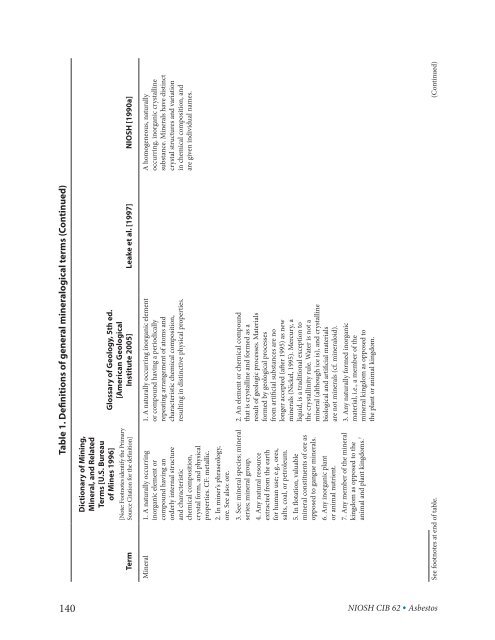Asbestos Fibers and Other Elongate Mineral Particles: State of the ...
Asbestos Fibers and Other Elongate Mineral Particles: State of the ...
Asbestos Fibers and Other Elongate Mineral Particles: State of the ...
- No tags were found...
You also want an ePaper? Increase the reach of your titles
YUMPU automatically turns print PDFs into web optimized ePapers that Google loves.
Table 1. Definitions <strong>of</strong> general mineralogical terms (Continued)<br />
140<br />
Glossary <strong>of</strong> Geology, 5th ed.<br />
[American Geological<br />
Institute 2005] Leake et al. [1997] NIOSH [1990a]<br />
Dictionary <strong>of</strong> Mining,<br />
<strong>Mineral</strong>, <strong>and</strong> Related<br />
Terms [U.S. Bureau<br />
<strong>of</strong> Mines 1996]<br />
[Note: Footnotes identify <strong>the</strong> Primary<br />
Source Citation for <strong>the</strong> definition]<br />
Term<br />
A homogeneous, naturally<br />
occurring, inorganic crystalline<br />
substance. <strong>Mineral</strong>s have distinct<br />
crystal structures <strong>and</strong> variation<br />
in chemical composition, <strong>and</strong><br />
are given individual names.<br />
1. A naturally occurring inorganic element<br />
or compound having a periodically<br />
repeating arrangement <strong>of</strong> atoms <strong>and</strong><br />
characteristic chemical composition,<br />
resulting in distinctive physical properties.<br />
<strong>Mineral</strong> 1. A naturally occurring<br />
inorganic element or<br />
compound having an<br />
orderly internal structure<br />
<strong>and</strong> characteristic<br />
chemical composition,<br />
crystal form, <strong>and</strong> physical<br />
properties. CF: metallic.<br />
2. In miner’s phraseology,<br />
ore. See also: ore.<br />
2. An element or chemical compound<br />
that is crystalline <strong>and</strong> formed as a<br />
result <strong>of</strong> geologic processes. Materials<br />
formed by geological processes<br />
from artificial substances are no<br />
longer accepted (after 1995) as new<br />
minerals (Nickel, 1995). Mercury, a<br />
liquid, is a traditional exception to<br />
<strong>the</strong> crystallinity rule. Water is not a<br />
mineral (although ice is), <strong>and</strong> crystalline<br />
biological <strong>and</strong> artificial materials<br />
are not minerals (cf. mineraloid).<br />
3. Any naturally formed inorganic<br />
material, i.e., a member <strong>of</strong> <strong>the</strong><br />
mineral kingdom as opposed to<br />
<strong>the</strong> plant or animal kingdom.<br />
3. See: mineral species; mineral<br />
series; mineral group.<br />
4. Any natural resource<br />
extracted from <strong>the</strong> earth<br />
for human use; e.g., ores,<br />
salts, coal, or petroleum.<br />
5. In flotation, valuable<br />
mineral constituents <strong>of</strong> ore as<br />
opposed to gangue minerals.<br />
6. Any inorganic plant<br />
or animal nutrient.<br />
7. Any member <strong>of</strong> <strong>the</strong> mineral<br />
kingdom as opposed to <strong>the</strong><br />
animal <strong>and</strong> plant kingdoms. 7<br />
See footnotes at end <strong>of</strong> table. (Continued)<br />
NIOSH CIB 62 • <strong>Asbestos</strong>

















